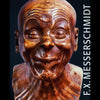Franz Xaver Messerschmidt 1736-1783
Pressedownload
Der Pressedownload darf nur im Zusammenhang mit einer Buchbesprechung verwendet werden. Für die Illustration einer Buchbesprechung können nur bis zu drei Bilder genutzt werden. Für andere Textformate und Nutzungszwecke (wissenschaftliche Vorträge, Werbung oder ähnliches) bitten wir Sie, vorab mit uns in Kontakt zu treten, um mögliche Fragen zu Honorarkosten, Nutzungsund Urheberrechten zu klären. Die bereitgestellten Bilddaten dürfen nicht manipuliert, beschnitten oder zweckentfremdet verwendet werden. Die Pressebilder dürfen nur mit dem vollständigen Bildtitel, dem Namen des Künstlers und/oder Urhebers sowie mit dem Hinweis auf den Hatje Cantz Verlag veröffentlicht werden. Bitte beachten Sie außerdem im Einzelfall die Reproduktionsbedingungen der VG Bild-Kunst Bonn bzw. der internationalen Verwertungsgesellschaften für Bildende Kunst.
Franz Xaver Messerschmidt 1736-1783
Smirking, dim-witted, grimacing or disgusted - that is how the character studies cast in lead or cut into alabaster appear to viewers: sculptures that do not adhere to any classical ideal of beauty but confront the viewer with a typology of the ugly. The fascinating character heads by the baroque sculptor Franz Xaver Messerschmidt may be indebted to his contemporary Johann Kaspar Lavater, yet, they never cease to amaze with their untimely artistic aggressiveness, modernism even, exposing the flip sides of human expression. Messerschmidt, who created conventional portraits of dignitaries such as Empress Maria Theresia or Joseph II while teaching at the Imperial Academy in Vienna, began to turn exclusively to character heads around 1770, a fact that quickly gained him the reputation of a maverick. Having taken early retirement due to a psychological disorder that was never clearly defined, he spent the rest of his life as a recluse in Pressburg. This extensive monograph about an exceptional artist attempts an interpretation of the "deeper meaning" of an oeuvre which is as unusual as it is uncompromising. (German edition available 3-7757-1245-3) The artist: Franz Xaver Messerschmidt (Wiesensteig 1736-1783 Pressburg), born as one of the numerous children in a dyer's family in the area Göppingen/Oberamt Geislingen, Württemberg. Move to Munich in 1746, subsequent apprenticeships with his uncles Johann Baptist Straub, wood sculptor at the Munich court, and Philipp Jakob Straub, sculptor in Graz. In 1755, studies in Vienna; from 1760 work for the imperial court, Vienna. Travels to Rome in 1765. From 1769, substitute professor for sculpture at the academy in Vienna. Moves to Pressburg in 1777.



